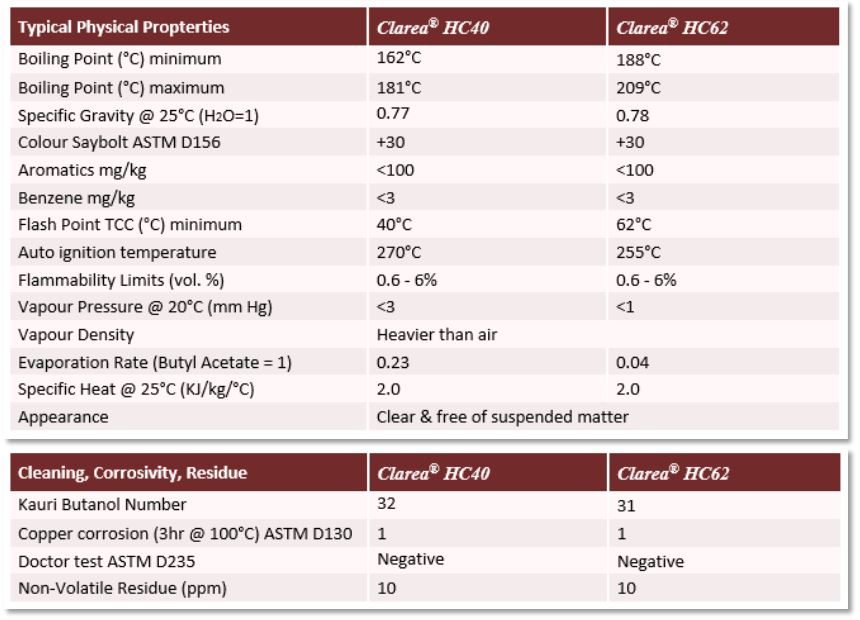Latest Articles
Advantages of using industrial solvent cleaners for the removal of dirt, oil, grease and other contaminants
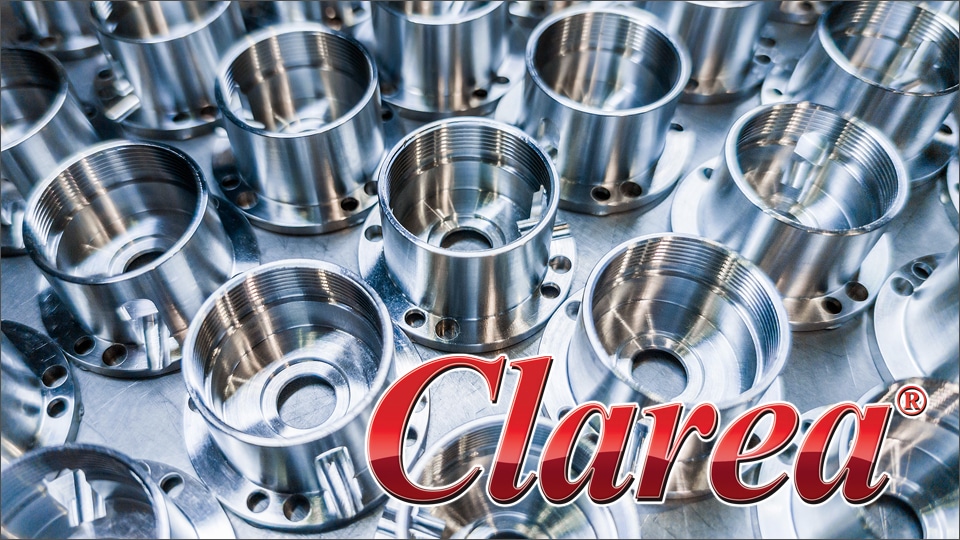
Advantages of using industrial solvent cleaners for the removal of dirt, oil, grease and other contaminants.
Industrial solvent cleaners are specialised cleaning products designed for use in industrial settings. They are formulated to tackle tough and stubborn contaminants found in industrial environments, such as heavy machinery, equipment, tools, and surfaces. They typically contain powerful solvents and cleaning agents capable of breaking down and removing various types of residues, including grease, oil, grime, chemicals, and more.
Organic solvents are used as the primary active ingredient, to dissolve and remove dirt, grease, oil, and other contaminants from surfaces. These chemicals can break down and disperse substances that are not water-soluble. Solvent cleaners are commonly used in various industrial applications for tasks where water-based cleaners are not effective. Industrial solvent cleaners offer several advantages in various applications and industries. The advantages of using industrial solvent cleaners include:
Effective Cleaning:
Industrial solvent cleaners are highly effective at removing a wide range of contaminants, such as grease, oil, paint, adhesives, and more. They can clean surfaces thoroughly, leaving them free from residue and contaminants.
High Solvency:
They have a high solvency power, allowing them to effectively dissolve and remove industrial contaminants that may not be easily cleaned with water-based solutions.
Fast Evaporation:
Many industrial solvent cleaners are formulated to evaporate quickly, leaving behind minimal residue and allowing for rapid cleaning and drying of surfaces.
Versatility:
Solvent cleaners can be used on a variety of surfaces, including metal, glass, plastic, and ceramics. This versatility makes them suitable for different industries and applications. They are often used for degreasing machinery and equipment in manufacturing facilities, automotive repair shops, and other industrial settings.
Fast Drying: Solvent cleaners typically evaporate quickly, leaving surfaces dry and ready for use. This is particularly important in industries where downtime must be minimized.
Precision Cleaning: Solvent cleaners are often used for precision cleaning tasks, such as cleaning electronic components, optical lenses, and medical devices, where cleanliness is critical.
Residue-Free Cleaning: Solvent cleaners are known for leaving minimal to no residue after cleaning, making them ideal for applications where residue could be problematic.
Compatibility: These cleaners are often compatible with a wide range of materials and coatings, reducing the risk of damaging the surfaces being cleaned.
Flammable and Non-Flammable Options: Depending on the specific needs of an application, both flammable and non-flammable solvent cleaners are available, allowing for safer operation in different environments.
Low Surface Tension: Solvent cleaners can penetrate into tight spaces and crevices due to their low surface tension, ensuring thorough cleaning.
Degreasing Capabilities: Industrial solvent cleaners are excellent at degreasing and removing oily residues, making them suitable for automotive, aerospace, and manufacturing industries.
Environmental Considerations: Some industrial solvent cleaners are formulated to be more environmentally friendly, with low VOC (volatile organic compound) and HAP (hazardous air pollutant) content, reducing their impact on the environment.
Regulatory Compliance: Many industrial solvent cleaners are formulated to meet specific industry standards and regulations, ensuring that they are safe and effective for use in various applications.
Long Shelf Life:
Solvent cleaners typically have a long shelf life, allowing for extended storage and usability.
While industrial solvent cleaners offer many advantages, it’s essential to use them with caution, especially those that are flammable, and to follow safety guidelines and regulations to protect workers and the environment. Additionally, it’s crucial to choose the right solvent cleaner for your application to achieve the best results while minimizing any potential drawbacks or risks.
EnviroTech Europe supply high quality hydrocarbon or chlorinated solvent cleaners for the safe removal of dirt, oil, grease and other contaminants
Clarea® industrial solvent cleaners are compatible with all metals, composites and most plastics used to remove dirt, oil, grease, or other contaminants from surfaces without causing harm or leaving residue. They are used as immersion cleaners for component cleaning in manufacturing andengineering industries and as wipe cleaners for large surface areas prior to painting or powder coating.
Clarea® industrial solvent cleaners are aliphatic hydrocarbon based, non-chlorinated, low odour degreasing solvents with specified flash points. They will remove oils, greases, hydraulic fluids cutting fluids and a wide variety of hydrocarbon based protective coatings. Can be safely used with all metals and composites and most plastic and paint finishes.
Clarea HC40 is low odour degreasing fast drying solvent with a flash point of 40°C. It is suitable for ultrasonic and dip systems and can be used with brush or in hand-wipe processes.
Clarea HC62 is a degreasing solvent with a flash point over 60°C. It is suitable for hand-wipe applications when used externally.
Clarea HC96 is a degreasing solvent with a flash point of 96°C. It is suitable for spray or immersion cleaning.
EFFICIENT AND ECONOMICAL
● Versatile and cost-effective solutions for all your industrial cleaning
● Minimal odour and low toxicity for operators
● Multipurpose uses can reduce the inventory of cleaning fluids.
● Flexible uses – evaporation rates suitable for hand wipe, spray, or immersion tank cleaning
● Contains no chlorine, other halogens or stabilisers
● Compatible with all metals and composites and most plastics
● Excellent pre-cleaner for paint or powder coatings
● Safe, reliable, environmentally friendly cleaning
Packaging and availability
Clarea® HC40 and Clarea® HC62 is available in the following container sizes and weights:
205 litre drums, 25 litre cans, 5 litre cans.
We can provide you with a Material Safety Data Sheets, independent laboratory reports, product samples and technical assistance.
For more information or advice please telephone us on +44 (0) 20 8281 6370 or use our contact form.
All products are supplied and supported by EnviroTech Europe Ltd. Manufactured in the United Kingdom and available on short delivery times through our dedicated team of distributors worldwide.
Share this page:
The importance of corrosion protection for electrical systems
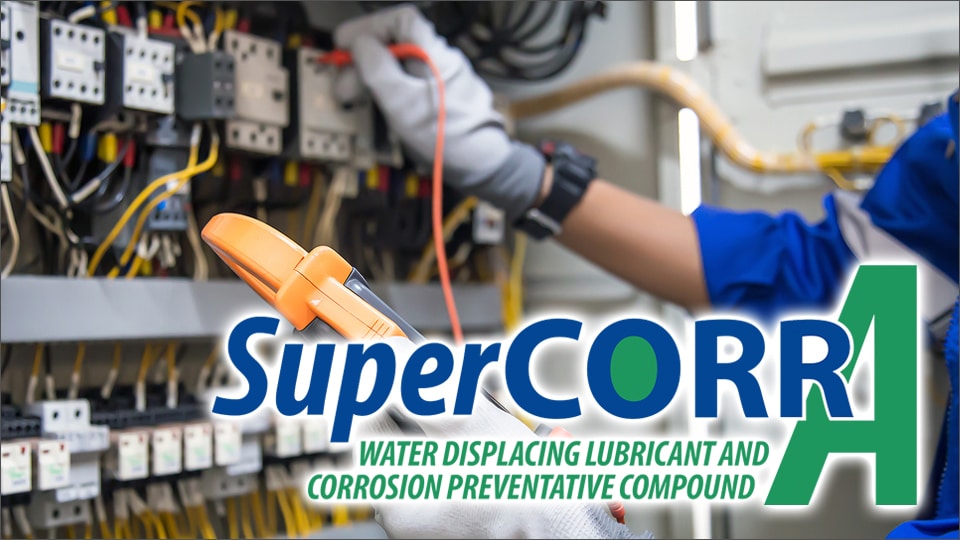
The importance of corrosion protection for electrical systems
Protection from corrosion is vital for safeguarding infrastructure and equipment, reducing costs, ensuring safety, and maintaining the reliability and longevity of critical electrical and electronic systems across various industries. Corrosion protection is critically important for several reasons.
Safety:
Corrosion can compromise the integrity of electrical components, leading to potential safety hazards. Damaged or corroded components can result in electrical short circuits, fires, or other dangerous situations.
Reliability:
Electrical systems are expected to function reliably over extended periods. Corrosion can lead to unexpected failures and downtime, disrupting operations and causing financial losses.
Performance:
Corrosion can degrade the performance of electrical connections, leading to increased resistance and reduced efficiency. This can result in wasted energy, increased operating costs, and reduced system performance.
Longevity:
Proper corrosion protection measures can extend the lifespan of electrical components and systems. By preventing or mitigating corrosion, you can reduce the frequency of maintenance and replacement, saving both time and money.
Energy Efficiency:
Corrosion can increase energy consumption. For example, in HVAC systems, corroded heat exchangers are less efficient, leading to higher energy bills.
Health and Safety:
Corrosion can compromise the safety of equipment and systems, leading to accidents and injuries. For instance, corrosion in the aviation industry can pose a significant risk to flight safety.
Reduced Maintenance Costs:
Dealing with the corrosion related issues listed above can be costly. Preventing corrosion through protective measures is always more cost-effective in the long run than repairing or replacing damaged components. Corrosion protection measures, such as coatings and inhibitors, can reduce the need for frequent maintenance and repair, saving both time and money.
Environmental Impact:
Corrosion can lead to the release of hazardous materials, such as lead, into the environment. Proper corrosion protection measures can reduce the environmental impact of electrical systems.
Economic Impact:
Corrosion costs industries billions of dollars each year in repair, maintenance, and replacement of corroded equipment. Effective corrosion protection measures can significantly reduce these costs.
Maintaining Signal Integrity:
In sensitive electronic systems, corrosion can affect the quality of signals and data transmission. For example, in telecommunications or data centres, corrosion-induced signal degradation can lead to communication errors, false signals or even data loss.
Aesthetic Considerations:
In some cases, electrical systems are visible to the public or customers. Corrosion can be unsightly and negatively impact the image and reputation of an organization.
Preventive Maintenance:
Implementing corrosion protection measures as part of a preventive maintenance program can help identify and address potential corrosion issues before they escalate, minimizing the risk of unexpected failures. Corrosion can cause equipment failures and operational disruptions. Corrosion protection measures ensure the reliable operation of critical electrical systems.
Regulatory Compliance:
In many industries, regulations and standards are in place that require the use of corrosion protection methods to ensure the safety and reliability of electrical systems. This is why Super CORR A is specified in the maintenance manuals for many aircraft manufacturers. Compliance with these regulations is essential to avoid legal and financial consequences.
Overall, corrosion protection is vital for safeguarding electrical and electronic equipment, reducing costs, ensuring safety, and maintaining the reliability and longevity of critical systems across various industries. Common methods of corrosion protection for electrical systems include the use of corrosion-resistant materials, coatings, sealants, periodic inspections, and maintenance, as well as environmental controls to reduce exposure to corrosive elements. Overall, prioritizing corrosion protection is essential for ensuring the safety, reliability, and longevity of electrical systems.
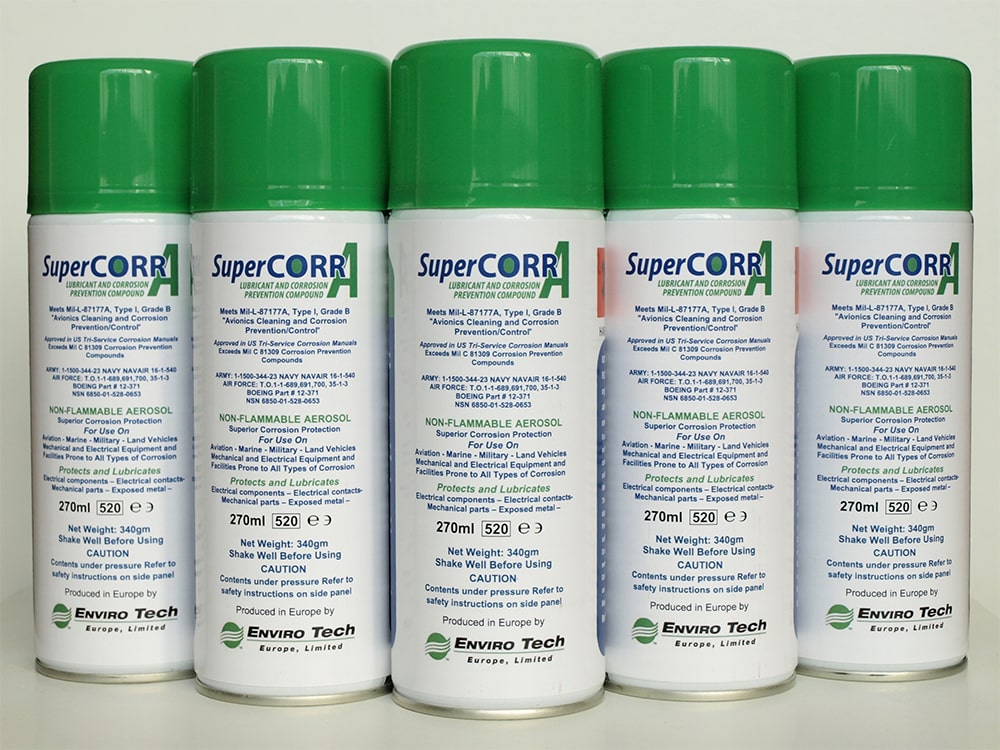
Specialist Barrier Film Corrosion Protection
EnviroTech Europe supplies advanced corrosion protection products, based on approved synthetic materials, to provide quality solutions to a range of lubrication and corrosion problems.
Super CORR A is a unique and proprietary formulation with long-lasting, anti-corrosion inhibitors providing a superior lubrication coefficient and protection against moisture, wear, general and fretting corrosion, static electricity, corona, and other electro migration problems. The non-flammable film is only 7 microns (0.007mm) in thickness, is not a wax or oil-based product and is formulated without sulphates, chlorides, petroleum-based material, or halogens, to meet the EU RoHS directive.
Super CORR A is unexcelled in preventing failures of electrical systems and electronic equipment caused by corrosion as well as preventing the corrosion of metal components surfaces. Use Super CORR A to protect connectors, electrical systems and switches and mechanical controls during servicing. It’s ability to displace water from exposed contacts can ensure reliable operation in extreme conditions, all from one small aerosol can.
The use of Super CORR A for corrosion control can not only bring financial savings in reduced maintenance and replacement costs but more importantly greater safety. It is much simpler and a lot less costly to prevent corrosion than to repair or replace the damaged equipment or component that failed because of corrosion.
Super CORR A is packaged in aerosol cans making access to component parts easy for engineering crews in difficult locations and conditions. Unpainted mild steel will not rust on exterior surfaces directly exposed to sea water environments for at least 6 months, protecting electrical connectors, switches, chains, drive shafts from corrosion while maintaining lubrication on moving surfaces.
EFFICIENT AND ECONOMICAL
- Extremely long-lasting, specially formulated and proprietary anti-corrosive inhibitor.
- Eliminates premature failure of components created by moisture, general or fretting corrosion.
- Prevents deterioration and contamination on all surfaces of electronic and electrical equipment and mechanical close tolerance moving components.
- Reliability increased, maintenance intervals increased and costs reduced, manufacturers save costly warranty service calls or product re-call.
APPROVED
- Industry approval from: NASA, Boeing Aircraft, Bombardier, Embraer, Lear, Gulfstream, Hawker-Beechcraft, Cessna, Raytheon, Polish Airforce, Northrop-Grumman, Royal Navy and Royal Norwegian Air Force.
- Exceeds Mil C 81309 Corrosion Prevention Compounds.
- Approved in US Tri-Service Corrosion Manuals.
FURTHER INFORMATION
Please visit our website https://www.envirotech-europe.com/supercorr-a for for information about other uses and applications for Super CORR A.
Visit www.envirotech-europe.com/applications-and-case-studies for information about uses and applications for all EnviroTech Europe products.
For more advice, please telephone us on +44 (0) 20 8281 6370 or use our website contact form. All products are supplied and supported by EnviroTech Europe Ltd. Manufactured in the United Kingdom and available on short delivery times through our dedicated team of distributors worldwide.
Share this page:
Why are vapour degreasing solvents so good at cleaning?
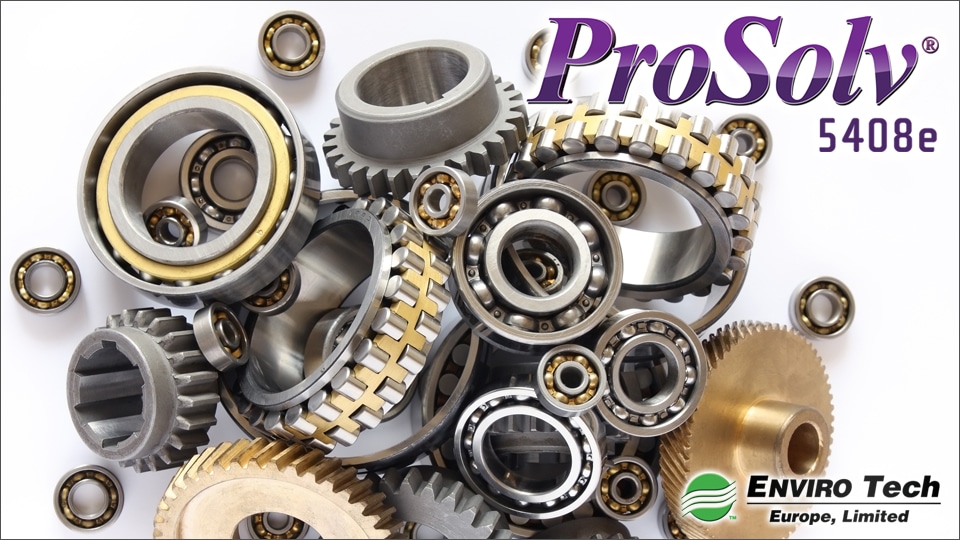
Why are vapour degreasing solvents so good at cleaning?
Vapour degreasing solvents are typically chosen for their excellent solvency properties. They have the ability to dissolve and disperse a wide range of contaminants, including dirt, oil, grease, wax, and other contaminants. The cleaning action of solvents is primarily attributed to their unique molecular properties and interactions with the materials they contact. Here’s why solvents are so good at cleaning:
Low Surface Tension:
Vapour degreasing solvents can reduce the surface tension of liquids, making them more effective at penetrating and breaking up dirt and stains. This allows the solvent to reach areas that might otherwise be hard to clean.
Polarity:
The polarity of a solvent plays a significant role in its cleaning ability. Polar solvents have molecules with positive and negative poles, which allows them to interact with polar substances like water-based stains. Nonpolar solvents, on the other hand, are effective at dissolving nonpolar substances like oils and grease. Different cleaning tasks may require the use of polar or nonpolar solvents depending on the nature of the dirt or stain. Most vapour degreasing solvents are nonpolar in nature, meaning they do not have a positive or negative charge. This allows them to interact with a variety of contaminants, regardless of their charge or polarity, making them versatile for different types of cleaning applications.
Heat and Vaporization:
The vapour degreasing process involves heating the solvent to create vapour, which rises and condenses on the surfaces to be cleaned. This condensation releases latent heat, which aids in loosening and lifting contaminants from the surfaces. The vaporization and condensation cycles help dislodge and carry away dirt, oils, and other substances effectively.
No Aqueous Residues:
Unlike water-based cleaning methods, vapour degreasing solvents leave little to no aqueous residue behind. This is especially important for applications where water could cause corrosion or damage, such as cleaning sensitive electronics or precision mechanical components.
Minimal Agitation Required:
Vapour degreasing is a relatively gentle cleaning method that doesn’t require extensive mechanical agitation. This reduces the risk of damaging delicate parts while ensuring effective cleaning.
Consistency:
Vapour degreasing provides consistent and uniform cleaning results because the solvent vapor can reach all surfaces evenly, including intricate and complex geometries.
Environmental Considerations:
While some vapour degreasing solvents in the past were environmentally concerning, modern solvents are designed to be safer and more environmentally friendly. They are engineered to have lower toxicity, reduced volatility, and minimal global warming or ozone-depleting potential.
Dissolving Power:
Solvents have the ability to dissolve a wide range of substances, both organic and inorganic. This is due to their molecular structure, which allows them to interact with different types of molecules. When a solvent comes into contact with a substance, its molecules surround and separate the particles of the substance, breaking down the intermolecular forces holding them together. This leads to the dissolution of the substance into the solvent.
Evaporation:
Vapour degreasing solvents typically have relatively low boiling points, which means they evaporate quickly when exposed to air. This evaporation helps in removing the dissolved dirt and contaminants from surfaces, leaving them clean and dry. It is important to ensure evaporating solvent doesn’t escape to the atmosphere. This is achieved by having cold condensing coils just above the components being cleaned.
Versatility:
Vapour degreasing solvents come in various types and compositions, allowing them to target specific types of contaminants. For example, alcohol-based solvents are effective at cleaning glass surfaces due to their ability to dissolve and evaporate quickly without leaving streaks.
Chemical Interactions:
Vapour degreasing solvents can undergo chemical reactions with certain types of substances, leading to their removal or transformation. This can be especially useful for removing tough stains that might not be easily removed through simple dissolution.
Compatibility:
Vapour degreasing solvents are often formulated to be compatible with specific materials, ensuring that they don’t damage the surfaces being cleaned. This makes them versatile for use on a wide range of surfaces.
Rinsing Action:
Vapour degreasing solvents can also act as rinsing agents, carrying away dissolved dirt and contaminants when they evaporate. This helps prevent redeposition of dirt onto cleaned surfaces.
Overall, the combination of excellent solvency, low surface tension, nonpolar properties, heat assistance, minimal residue, and controlled vaporization make vapor degreasing solvents highly effective for a wide range of cleaning applications.
It’s important to note that while solvents are effective cleaning agents, their use should be handled with care. Some solvents can be toxic, flammable, or harmful to human health and the environment, so proper precautions and guidelines should be followed when using them. Additionally, choosing the right solvent for a specific cleaning task is crucial to achieve optimal results without causing damage to the surfaces being cleaned.
Zero Ozone Depletion Potential (ODP) and very low Global Warming Potential (GWP) solvent cleaner for high performance vapour degreasing
ProSolv® 5408e has been developed to provide superior critical cleaning performance for manufacturers of electronic and electrical components. High Solvency (KB Value 98) for removal of organic residues, compatible with organic and synthetic oils and most plastics and metals.
ProSolv® 5408e is a high-performance solvent cleaner used for sustainable and future proof vapour degreasing. It has a GWP of less than 1, with a 100 year Integrated Time Horizon (ITH). Soft on the environment and safe for users, it offers improved cleaning at lower costs.
ProSolv® 5408e ticks all the boxes and is the perfect profile for a modern vapour degreasing solvent. Exceptionally low surface tension to penetrate micron sized holes and close contact surfaces. Sustainable and secure for the future. Non-carcinogenic, low boiling point, economical with energy with low solvent losses, faster production, reduced costs, easy handling.
EFFICIENT AND ECONOMICAL
- Fast precision cleaning with short cycle times.
- Can be used in any vapour degreasing equipment, lower energy consumption and lower maintenance.
- Ideal replacement for Trichloroethylene, n-Propyl Bromide, Perchloroethylene and HCFC based solvents.
- Stable with no additives, no testing required.
- Improved productivity, parts exit the machine cool, dry and spot-free with no drying required.
- Minimal non-volatile residue (>10ppm).
- High density solution, excellent for ultrasonic cleaning.
- Mid-range boiling point (46°C).
- Very low surface tension for penetration into the micron level crevices and holes, efficient cleaning in tight to reach places and complex geometries.
- Easy process monitoring with minimal effort and minimal waste generation, easy reclamation for reuse.
- High Solvency (KB Value 98) for a variety of contaminants.
- Compatible with a broad range of substrates.
SAFE FOR USERS AND THE ENVIRONMENT
- Safe for the environment, Zero Ozone Depletion Potential (ODP).
- Very low Global Warming Potential (GWP)
- GWP of less than 1, AR4 100yr Integrated Time Horizon (ITH).
- Non-hazardous for transportation.
- Non-flammable (No Flash Point).
- Not classified as a carcinogen
Listed above are some of the benefits from using ProSolv® 5408e, a sustainable vapour degreasing solvent for precision cleaning and an economical and efficient replacement solution for cleaning systems using older legacy solvents, which are now either banned or being phased out. EnviroTech Europe have many years of experience and our experts are available to guide you through your solvent cleaner changeover procedures or to advise on equipment.
FURTHER INFORMATION
Please visit our website https://www.envirotech-europe.com/prosolv5408e for information about other uses and applications for ProSolv 5408e.
Visit www.envirotech-europe.com/applications-and-case-studies for information about uses and applications for all EnviroTech Europe products.
For more advice, please telephone us on +44 (0) 20 8281 6370 or use our website contact form.
All products are supplied and supported by EnviroTech Europe Ltd. Manufactured in the United Kingdom and available on short delivery times through our dedicated team of distributors worldwide.
Share this page:
Related Posts
Latest News
Replacements for nPB
Envirotech Europe introduce low cost “drop in” replacements for nPB (n-propyl bromide) vapour degreasing solvents.
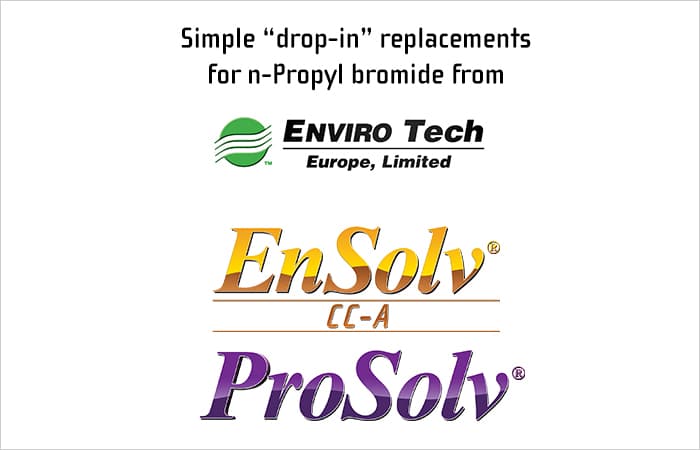
Bad news for your business. Coronavirus, Brexit, redundancies, social distancing reduced cash flow.
If that’s not enough and you are using nPB solvent that’s another problem to worry about as its use for vapour degreasing has been banned by the EU since July. Don’t panic it’s not too late to change and comply, as we have “drop in” replacements for nPB which are guaranteed to give the same results at no increase in your costs of usage. It is late but we can give you the information to easily make the change in a day without fuss.
You have questions – of course:
How can it be so simple?
The EnSolv range of stabilised nPB based vapour degreasing solvents has been the market leader in this field worldwide for many years. EnviroTech Europe, the manufacturers, know this product inside out with hundreds of satisfied users. We have been fighting the EU authorities for 20 years regarding classification, but with limited resources and the corporate giants with money to lose as EnSolv gained more and more of the market. Money talks so the Commission ignored the evidence and banned nPB for use as a vapour degreasing solvent with the sunset date in July 2020. If you are interested in the history, it is all explained in detail on our website.
With our extensive knowledge of user needs EnviroTech Europe, during the intervening years, have developed new compliant solvent formulations which are simple “drop-in” replacements.
No new equipment needed, guaranteed results and no extra costs to worry about.
We can’t guarantee that more changes will not happen in the future, but you will then have time to evaluate whether the new generation of wonder products which reduce global warming a smidgeon is worth the enormously increased costs.
Talk to us about whether EnSolv CC-A or ProSolv will be the best choice for your application. Advice, literature, changeover instructions are all available to make the change quickly, easily and at no extra cost of usage.
For more information about replacing nPB please visit:
www.vapour-degreasing.com/npb-replacement
We can provide you with a Material Safety Data Sheets, independent laboratory reports, product samples and technical assistance.
For more information or advice please telephone us on +44 (0) 20 8281 6370 or use our contact form.
All products are supplied and supported by EnviroTech Europe Ltd. Manufactured in the United Kingdom and available on short delivery times through our dedicated team of distributors worldwide.
Share this page:
Related Posts
Corrosion Protection Spray – SuperCORR A
SuperCORR A corrosion protection spray protects and revitalises production machines during Coronavirus lockdowns.
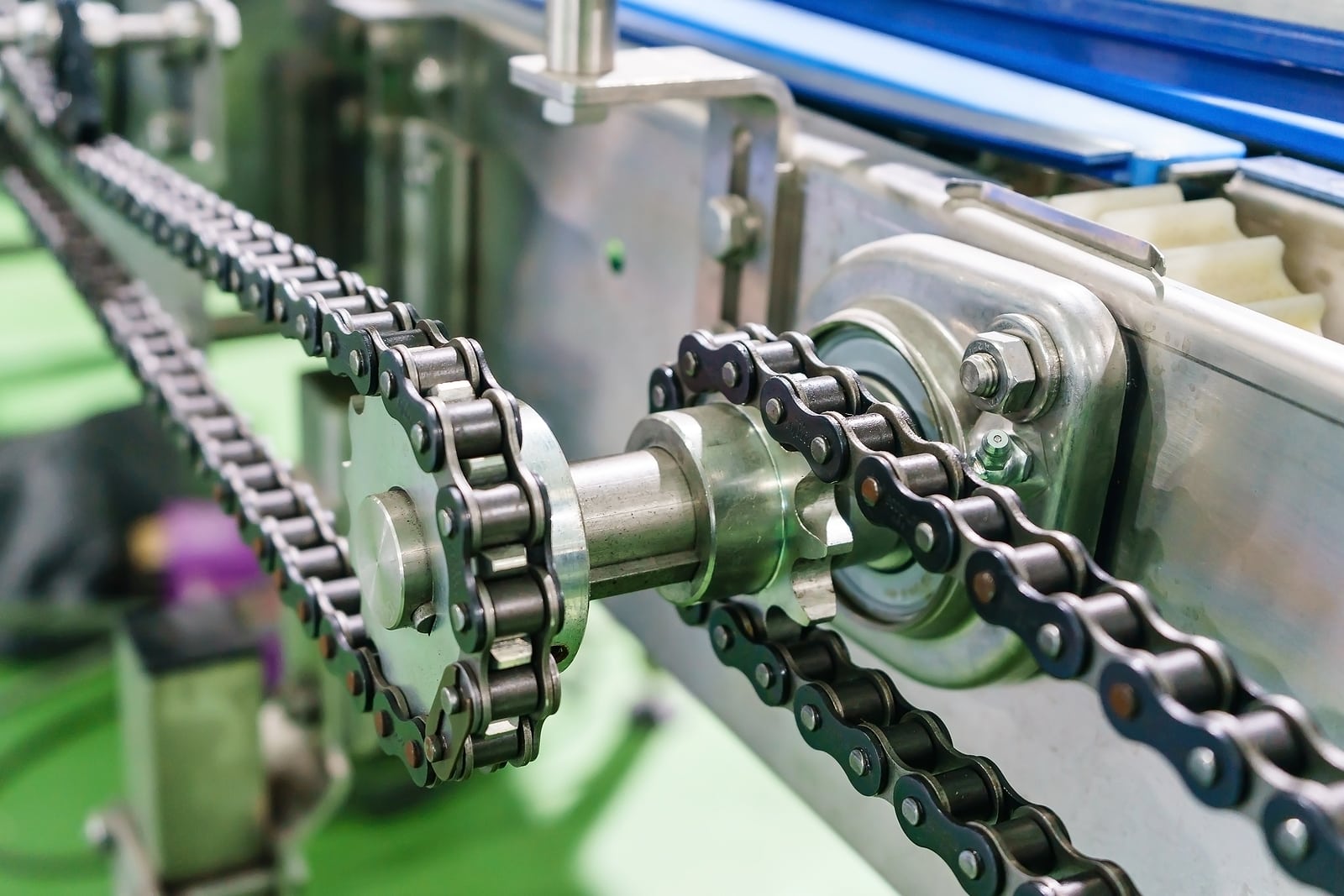
Spraying a coating when shutting down machines, drives, conveyor chains and in control cabinets will prevent or displace condensation on exposed surfaces protecting against condensation. A further spray on reopening and restart displaces any surface moisture which may have accumulated and relubricates moving components.
SuperCORR A is a proprietary formulation containing no organic constituents. A combination of long lasting synthetic anticorrosion inhibitors and lubricants that protects metal components against moisture. This unique, water displacing lubricant is non-flammable and environment friendly.
Unexcelled in preventing corrosion and contamination on all surfaces in mechanical close tolerance slow moving components or electrical and electronic equipment used in humid conditions. Can be used on any metal surfaces to prevent flash rusting, microbial and other forms of corrosion.
SuperCORR A forms a super thin, hydrophobic, non-flammable lubricant film with anti-corrosion properties approximately 7 microns (0.007mm) in thickness and is compliant with U.S. EPA regulations, the European Union RoHS Directives
Conforms to MIL-DTL-87177B (Revised MIL-L-87177A) specifications.
For more information please visit www.corrosion-protect.com/supercorr-a To discuss the use of SuperCORR A to solve your corrosion protection problems please use the website contact form or phone us, we look forward to hearing from you.
We can provide you with a Material Safety Data Sheets, independent laboratory reports, product samples and technical assistance.
For more information or advice please telephone us on +44 (0) 20 8281 6370 or use our contact form.
All products are supplied and supported by EnviroTech Europe Ltd. Manufactured in the United Kingdom and available on short delivery times through our dedicated team of distributors worldwide.
Share this page:
Related Posts
Improve connector maintenance on portable gas generators
Why using SuperCORR A for connector maintenance on portable gas generators improves electrical supplies in extreme conditions.
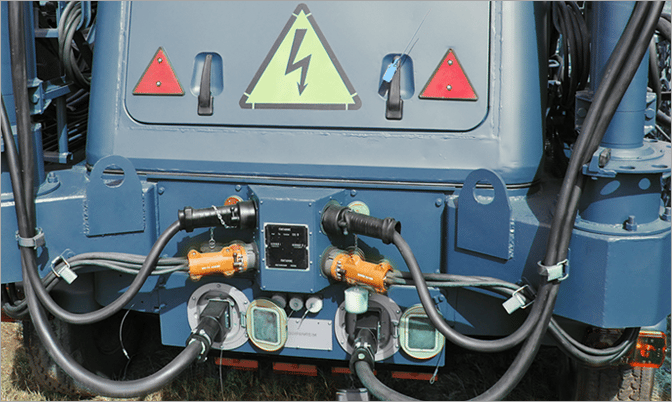
Portable generators maintain aircraft services at standings are connected and disconnected many times a day in extreme weather conditions.
These applications and locations test connector seals allowing dust or water to infiltrate. This with the flexing of the connecting cables allows sufficient movement between the metal surfaces of the connecting pins to produce fretting corrosion which reduces, interrupts or produces failures in electrical supply. Regular maintenance of electrical connectors and control systems is vital to be certain of uninterrupted supply.
SuperCORR A is an aerosol lubricant containing corrosion preventive compounds, which, as is the case with all lubricants, can be worn off over time.
A leading manufacturer of connectors tested SuperCORR A to see what the “life” of the lubricant was in a “rub test”. The typical test is 20,000 cycles, i.e. unplug, plug in is one cycle. The test results demonstrated that after 20,000 cycles there were no failures. It was decided to take it one more step and run the same tests for 200,000 cycles. The results again showed no indications of galling or scoring on the connectors at all. The connector looked and tested as good as new. This test was run under clean conditions in a laboratory but demonstrates the effectiveness of the protective lubricant in SuperCORR A.
As it meets Mil- MIL-DTL-87177B (Revised MIL-L-87177A) specifications SuperCORR A is used by the U.S. Air Force to protect the intricate workings of the F-16 Fighter Jet and by the U.S. Navy on the P 3 Orion electronic surveillance aircraft. Commercial aviation aircraft manufacturers recommend it for electrical and close metal mechanical application, especially where flights are in salt fog or high humidity.
Containing extremely long-lasting, proprietary anti-corrosive inhibitors SuperCORR Aprovides a superior lubrication coefficient and protects components against moisture, wear, general and fretting corrosion, surface static electricity, corona, and other electro migration problems. The super thin non-flammable lubricant film is only 7 microns (0.007 mm) thick and is formulated without sulphates, chlorides or halogens to meet the RoHS directive. It is unexcelled in preventing deterioration and contamination on all surfaces of electronic equipment.
Very fast drying environmentally acceptable solvents are used as carriers and propellants which will not affect most plastics, substrates, metals or other materials used in connector manufacture.
The aerosols are supplied with probes allowing access to pins and connector tubes where the low surface tension repels water, dirt dust and metal particles from blind holes and surfaces to produce thoroughly clean holes before a second application applies the lubricant film. Reconnection to the supply with cleaned sections of the connector ensures reliable operation even in the most testing of environments. This easy maintenance from one can of
SuperCORR A allows this essential task to be carried out in any conditions quickly, easily and securely.
For more information please visit www.corrosion-protect.com/supercorr-a To discuss the use of SuperCORR A to solve your problems please use the website contact form or phone us, we look forward to hearing from you.
We can provide you with a Material Safety Data Sheets, independent laboratory reports, product samples and technical assistance.
For more information or advice please telephone us on +44 (0) 20 8281 6370 or use our contact form.
All products are supplied and supported by EnviroTech Europe Ltd. Manufactured in the United Kingdom and available on short delivery times through our dedicated team of distributors worldwide.
Share this page:
Related Posts
Replace n-Propyl bromide with ProSolv vapour degreasing solvent
High performance vapour degreasing solvent, simple “drop-in” replacement for n-Propyl bromide and trichloroethylene.
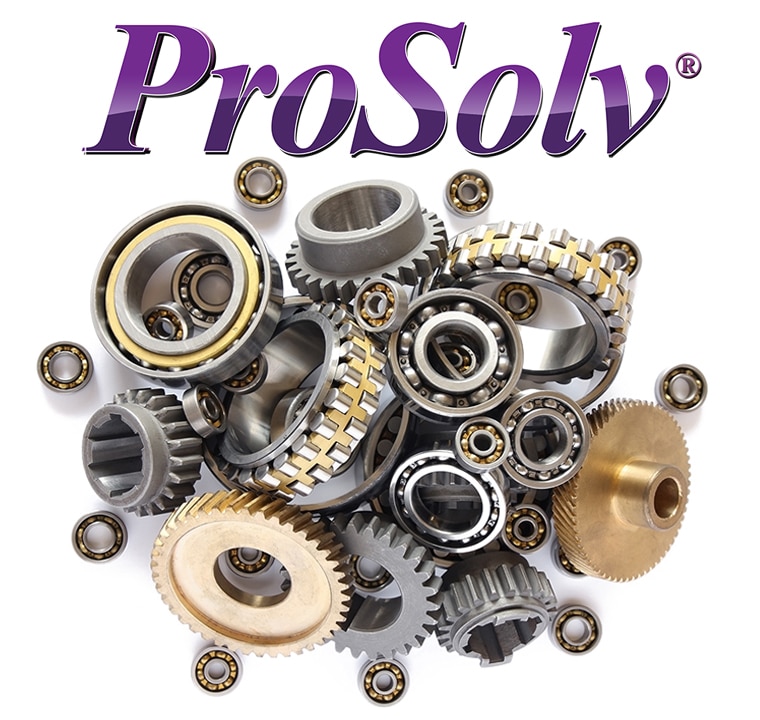
ProSolv® is an alternative chemistry developed by EnviroTech Europe to replace chlorinated solvents. It can be used in most existing vapour degreasing equipment and can be used safely for immersion cleaning using ultrasonics, for which it has been optimised. with a high specific gravity and very low surface tension.
Unlike some other chlorinated and halogenated blends such as trichloroethylene, ProSolv® is an excellent choice to replace flammable solvents such as MEK, Acetone, Isopropyl alcohol (IPA) or hydrocarbons where manual wiping or brush cleaning is the preferred method. It is a non-flammable azeotropic blend which can be used for manual cleaning in suitably ventilated areas and recycled by distillation for reuse through many cycles. It is a very stable mixture with no need for monitoring or the need for additives or stabilisers.
In other applications ProSolv® offers a cost-effective alternative for halogenated solvents in formulations for dip, spray or aerosol applications and as a fast-drying carrier solvent for oil, silicones and other lubricants. Simple to install in any standard machine for vapour and vapour liquid degreasing.
ProSolv® is non-flammable (No Flash Point) with high solvency (KB Value 91) with a very low surface tension and low boiling point making it highly productive and economical in use. A very stable azeotrope in use no additives or testing required. Leaves minimal non-volatile residue.
Importantly the ProSolv® formulation is kind to the environment as it contains no hazardous air pollutants and is safe for users. It has zero ozone depletion (ODP) with very low global warming potential (GWP). ProSolv® is compatible with all metals.
Manufactured in UK with excellent customer service, technical support and training from qualified distributors throughout Europe.
We can provide you with a Material Safety Data Sheets, independent laboratory reports, product samples and technical assistance.
For more information or advice please telephone us on +44 (0) 20 8281 6370 or use our contact form.
All products are supplied and supported by EnviroTech Europe Ltd. Manufactured in the United Kingdom and available on short delivery times through our dedicated team of distributors worldwide.
Share this page:
Related Posts
Alternatives to nPB
nPB solvent for vapour degreasing is banned from July 2020 – EnviroTech Europe has low cost, “drop-in” alternatives to nPB.
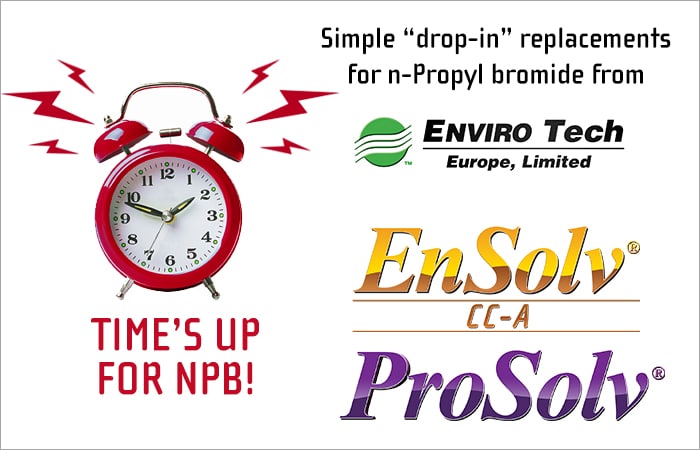
nPB solvent for vapour degreasing is banned from July 2020 – EnviroTech Europe has low cost, “drop-in” alternatives to nPB.
Bad news for your business. Coronavirus, Brexit, redundancies, social distancing reduced cash flow.
If that is not enough and you are using nPB solvent for vapour degreasing that’s another problem to worry about as it cannot be used after 4th July. Don’t panic it’s not too late to change and comply, as we have “drop in” replacements which are guaranteed to give the same results at no increase in your costs of usage. It is late but we can give you the information to easily make the change in a day without fuss.
You have questions – of course:
How can it be so simple?
The EnSolv range of stabilised nPB based vapour degreasing solvents is the market leader in this field worldwide. EnviroTech Europe, the manufacturers, know this product inside out with hundreds of satisfied users. We have been fighting the EU authorities for 20 years regarding classification, but with limited resources and the corporate giants with money to lose as EnSolv gained more and more of the market. Money talks so the Commission ignored the evidence and banned nPB for use as a vapour degreasing solvent with the sunset date in July 2020. If you are interested in the history, it is all explained in detail on our website.
With our extensive knowledge of user needs EnviroTech Europe, during the intervening years, have developed new compliant solvent formulations which are simple “drop-in” replacements.
No new equipment needed, guaranteed results and no extra costs to worry about.
We can’t guarantee that more changes will not happen in the future, but you will then have time to evaluate whether the new generation of wonder products which reduce global warming a smidgeon is worth the enormously increased costs.
Talk to us about whether EnSolv CC-A or ProSolv will be the best choice for your application. Advice, literature, changeover instructions are all available to make the change quickly, easily and at no extra cost of usage.
For more information about replacing nPB please visit:
www.vapour-degreasing.com/npb-replacement
We can provide you with a Material Safety Data Sheets, independent laboratory reports, product samples and technical assistance.
For more information or advice please telephone us on +44 (0) 20 8281 6370 or use our contact form.
All products are supplied and supported by EnviroTech Europe Ltd. Manufactured in the United Kingdom and available on short delivery times through our dedicated team of distributors worldwide.
Share this page:
Related Posts
Lubricant and corrosion protection spray
SuperCORR A multitasking lubricant and corrosion protection spray solving problems across industry.
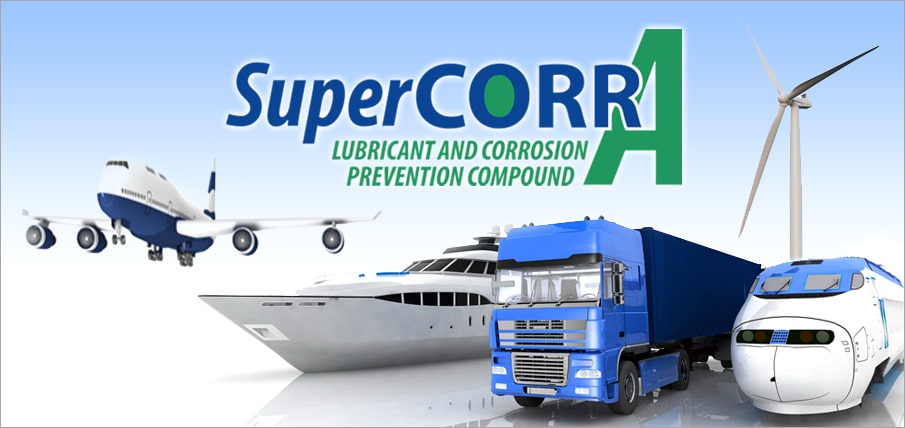
Originally developed to comply with military standards for a lubricant and corrosion protective for the USAF (MIL- DTL- 8717B Type 1 Avionics cleaning and corrosion prevention and control) SuperCORR A is now the industry standard for in service maintenance by military and commercial airlines and MOR facilities worldwide. It is recognised for its unique formulation which contains extremely long-lasting, proprietary anti-corrosive inhibitors providing a superior lubrication coefficient and protecting components against moisture, wear, general and fretting corrosion, surface static electricity, corona, and other electro migration problems. The ultra-thin non-flammable lubricant film is only 7 microns (0.0007 inch) thick and is formulated without sulphates, chlorides or halogens to meet the EU RoHS directive. It is unexcelled in preventing deterioration and contamination on all surfaces of electronic equipment and metal components.
Its use in aircraft is well established for maintenance but major aerospace and turbine manufacturer is currently completing trials with SuperCORR A to protect machined parts in transit and storage, worldwide, under variable temperature and humidity conditions against corrosion during long term storage. The protective film is self-sealing during movement and handling and can be removed before use if necessary.
Amongst other established uses for mercantile lubrication and corrosion protection suppliers of marine maintenance packages, which include SuperCORR A, to ships on docking. These are used for routine lubrication and anticorrosion maintenance in the harsh conditions experienced at sea. The aerosol cans make access to parts easy for the engineering crew in difficult locations on ship. Unpainted mild steel will not rust on exterior surfaces directly exposed to sea water spray for at least 6 months protecting electrical connectors, switches, chains, drive shafts from corrosion while maintaining lubrication on moving surfaces.
In another interesting application SuperCORR A reduces maintenance under extreme conditions to protect the metal edges of the composite blades on wind turbines. These are subject to the continuous corrosive effects of wind, rain and salt laden sea spray which erodes and corrodes the metal. The protective film produced by application of SuperCORR A is impervious to water and lubricates the airflow across the blade edges preventing corrosion of the metal. Safety on these wind turbines where maintenance engineers are working at great height and perilous conditions of exposure to high winds entails reliance on critical fall arrest equipment. Corrosion in the bearings, clutches and wires used in the arrester mechanisms can lead to failure and potentially serious injury or loss of life. SuperCORR A protects against corrosion in these safety critical components.
The oil and gas industries use SuperCORR A as a reliable easily applied protective coating against corrosion of tools and parts in storage and transit. High humidity and wide fluctuations in temperature experienced on oil rigs at sea and on land need the same protection and lubrication for critical fall arresters used on wind turbines and in other situations where working at high levels in extreme weather conditions imposes the same risks.
Monitoring systems, electronics. switches and moving surfaces also need protection and SuperCORR A being based on nonorganic lubricants will not attack or degrade the materials used in manufacturing the components but reject water from protected surfaces preventing shorts, and by preventing fretting corrosion ensuring good connections and smooth movement in bearings and chains.
Portable diesel and LP generators are widely used in the oil and gas and mineral extraction industries in remote, hostile environments. Between flights aircraft services are powered by generators during loading and unloading and maintenance. All these uses require connection and disconnection, often many times a day. Connector seals, when broken, allows water, sand or dust to penetrate and with the flexing of the connector cables allows sufficient movement between the metal surfaces of the connector pins to produce fretting corrosion. A simple spray between connection breaks ejects water and particulates and protects and lubricates the contacts improving reliability of supply.
Building and construction industries offer other unusual uses for SuperCORR A. Unpainted hatches, grilles, and window furniture are galvanised if manufactured in steel and anodised if aluminium or a zinc alloy. These need protection in storage against scratches and once installed exposure to wind and especially acidic rain dulls surfaces and produces unsightly white surface corrosion. An onsite spray with SuperCORR A on completion of the installation protects the surfaces with an invisible film and at the same time applies a lubricant film to hinges and bearings in handles and other moving parts such as window openers reducing the needs for maintenance often in inaccessible places at high level.
In all forms of transportation from Amtrac trains, DLR and other lightweight rail systems and for protection of transit equipment and services for underground tunnels and systems to motorsport. racing and rally cars, electric cars and on emergency vehicles SuperCORR A is used for protection and lubrication of connectors, electrical systems and switches, mechanical controls during manufacture, assembly and servicing. Haulage is another area where the ability to displace water from exposed contacts can ensure reliable operation in extreme conditions.
The unique combination of properties in one small aerosol can gives maintenance and service engineers a very safe solution to an enormous range of problems.
For more information please visit www.corrosion-protect.com. To discuss the use of SuperCORR A to solve your problems please use the website contact form or phone us, we look forward to hearing from you.
We can provide you with a Material Safety Data Sheets, independent laboratory reports, product samples and technical assistance.
For more information or advice please telephone us on +44 (0) 20 8281 6370 or use our contact form.
All products are supplied and supported by EnviroTech Europe Ltd. Manufactured in the United Kingdom and available on short delivery times through our dedicated team of distributors worldwide.
Share this page:
Related Posts
Replace nPB
Bad news for your business! Coronavirus, Brexit, redundancies, social distancing reduced cash flow! If that’s not enough! Now needing to replace nPB solvent for vapour degreasing is another problem to worry about as it will not be available after 4th July.

Don’t panic it not too late to change and comply as we have “drop in” replacements for n-Propyl Bromide (nPB) which are guaranteed to give the same results within your budget and no increase in usage.
It is late but we can give you the information to easily make the change in a day without fuss.
You have questions – of course – for example: How can it be so simple?
The EnSolv range of stabilised nPB based vapour degreasing solvents is the market leader in this field worldwide. EnviroTech Europe the manufacturers know this product inside out with hundreds of satisfied users around the world. We have been championing nPB as a cleaning solvent to the EU authorities for twenty years regarding classification.
Over this time EnSolv gained more and more of the market, unfortunately being a small family orientated, customer focused company with limited cash and resources the Commission ignored the evidence and banned nPB for use as a vapour degreasing solvent with the sunset date in July 2020.
If you are interested in the history, it is all explained in detail on our website.
With our extensive knowledge of user needs EnviroTech Europe, during the intervening years, have developed new compliant solvent formulations which are simple
drop-in replacements.
No new equipment needed, guaranteed results and no extra set up costs to worry about.
We can’t guarantee that more changes will not happen in the future but you will have a seamless change over and we will then in time let you evaluate our new generation wonder product which has zero global warming and zero ozone depletion, at a very competitive cost.
Right that’s one problem out of the way, sorry we can’t help with the others!
Talk to us about whether EnSolv CC-A or ProSolv will be the best choice for your application. Advice, literature, changeover instructions are all available to make the change quickly, easily and at no extra cost of usage.
For more information about replacing nPB please visit:
www.vapour-degreasing.com/npb-replacement
We can provide you with a Material Safety Data Sheets, independent laboratory reports, product samples and technical assistance.
For more information or advice please telephone us on +44 (0) 20 8281 6370 or use our contact form.
All products are supplied and supported by EnviroTech Europe Ltd. Manufactured in the United Kingdom and available on short delivery times through our dedicated team of distributors worldwide.
Share this page:
Related Posts
Replacement for n-Propyl bromide and trichloroethylene
Prosolv – A high performance vapour degreasing solvent and simple “drop-in” replacement for n-Propyl bromide and trichloroethylene
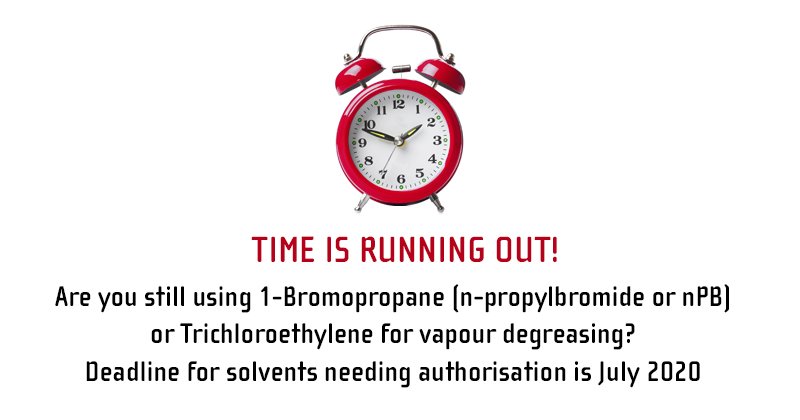
Vapour degreasing is one of the most widely used cleaning systems in the engineering industry. The most commonly used solvents are based on Trichloroethylene, n-Propyl bromide and other chlorinated solvents which under EU REACH regulations may require authorisation for use as metal cleaners after July 2020. If you are using vapour degreasing solvents based on any of these solvents EnviroTech Europe can offer excellent drop-in replacement products developed from 40 years of experience supplying market leading cleaning solvents to the engineering industries.
ProSolv® is an alternative chemistry developed by EnviroTech Europe to replace chlorinated solvents. It can be used in most existing vapour degreasing equipment and can be used safely for immersion cleaning using ultrasonics, for which it has been optimised. with a high specific gravity and very low surface tension.
ProSolv® is an extremely stable and simple to use vapour degreasing solvent. A tertiary azeotrope which blends the properties of solvents in the formulation to meet all the increasingly stringent demands of legislators for safer, non- flammable solvents with a low environmental impact while delivering high performance vapour degreasing in the precision engineering industries.
Unlike some other chlorinated and halogenated blends such as trichloroethylene, ProSolv® is an excellent choice to replace flammable solvents such as MEK, Acetone, Isopropyl alcohol (IPA) or hydrocarbons where manual wiping or brush cleaning is the preferred method. It is a non-flammable azeotropic blend which can be used for manual cleaning in suitably ventilated areas and recycled by distillation for reuse through many cycles. It is a very stable mixture with no need for monitoring or the need for additives or stabilisers.
In other applications ProSolv® offers a cost-effective alternative for halogenated solvents in formulations for dip, spray or aerosol applications and as a fast-drying carrier solvent for oil, silicones and other lubricants. Simple to install in any standard machine for vapour and vapour liquid degreasing.
ProSolv® is non-flammable (No Flash Point) with high solvency (KB Value 91) with a very low surface tension and low boiling point making it highly productive and economical in use. A very stable azeotrope in use no additives or testing required. Leaves minimal non-volatile residue.
Importantly the ProSolv® formulation is kind to the environment as it contains no hazardous air pollutants and is safe for users. It has zero ozone depletion (ODP) with very low global warming potential (GWP). ProSolv® is compatible with all metals.
Manufactured in UK with excellent customer service, technical support and training from qualified distributors throughout Europe.
We can provide you with a Material Safety Data Sheets, independent laboratory reports, product samples and technical assistance.
For more information or advice please telephone us on +44 (0) 20 8281 6370 or use our contact form.
All products are supplied and supported by EnviroTech Europe Ltd. Manufactured in the United Kingdom and available on short delivery times through our dedicated team of distributors worldwide.
Share this page:
Related Posts

